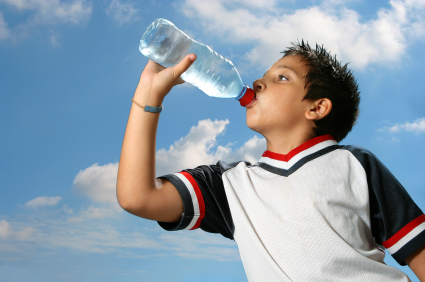Parents in a 2012 study1 report that, while their kids frequently consume sports drinks and sugar-sweetened beverages (ie. juice, soda) during sport, they were unsure about whether the drinks were appropriate and under what circumstan ces.
ces.
Citing a recommendation by the American Academy of Pediatrics' Committee on Nutrition and Council on Sports Medicine and Fitness2 that all children and adolescents avoid sports drinks because they increase the risk of obesity, the authors suggest that youth sports leagues take an active role in promoting water as the preferred beverage.
Sports drinks sometimes appropriate
But is water always the right beverage choice? In what circumstances are sports drinks appropriate?
To shed some light on the subject of sports drinks, MomsTEAM asked consultant, speaker, Spinning instructor, and registered dietitian, Tammy Beasley, RD, CSSD, LD, CEDRD, and founder and creator of Rev It Up!, to weigh in.
Here's what Beasley told us:
- The AAP's recommendation that all children avoid sports drinks because of their increased risk of overweight or obesity, "makes me sigh, literally, because IF the sports drinks are used as they are designed to BE USED, NOT as a substitute for sodas or Koolaid, and not as a beverage when playing video games, sitting around, etc, BUT used as an electrolyte and fluid and energy replacement AFTER ONE HOUR OF SOLID ACTIVITY has taken place, their consumption IS appropriate.
- The studies are extensive on the appropriateness and benefit of sports drinks if used as they are designed to be used: for sports activities when an individual, child or adolescent or adult, has been active for an hour already and will continue to be active for additional time. Water replaces [fluid losses] perfectly for that first hour, but, after that, the body needs more than just water - it needs sodium, potassium and an easily digestible sugar source in a small percentage to avoid high osmolality in the gut. Sports drinks are designed for that purpose.
- The problem lies in the fact that they are so often used as an alternative to a soda, and the sugar content - albeit half of what a soda can has - is not necessary and certainly will lead to overweight issues if consumed in excess. They are not a beverage alternative to use randomly, they are specifically designed for ACTIVITY, and have a real scientific place for replenishment for the athlete when used according to guidelines.
- Certainly sodium and potassium and carbohydrates can be consumed in solid foods, but appetite is naturally suppressed during exercise and I have yet to find many individuals willing to replace what their body needs at that point in time by eating solid foods, so finding a liquid alternative makes sense.
- Education, of the coaches and nutrition authorities and peer role models, translated to the kids and their parents, is key here."
Part of the problem, Beasley says, lies in the fact that the amount of true activity is not taken into account: just because a practice lasts two hours does not mean that the child has been ACTIVE for two hours solid. It is sport-dependent too. A soccer practice is going to be much more active than a baseball practice, in which the players are taking turns batting, and taking turns doing drills in the field.
Environmental factors
Environment also plays a role:
- a long baseball practice in 100 degree weather in the middle of the day will warrant use of an electrolyte sports drink due to excessive sweat even if the activity level isn't consistent.
- A two-hour swim practice, although in cool water, warrants use of an electrolyte sports drink after that first hour despite the fact that the athlete is not physically ‘sweating' per se but because activity is constant and the body is still losing electrolytes even in the pool due to that constant activity.
Rule of thumb
"A rule of thumb I use often, says Beasley, "is water for first hour, then sports drink for replacement. If outside for a long duration, in hot humid environment, I recommend alternating water and sports drinks from the beginning (for example, a double header baseball game in midday heat).
Again, I don't think we should blame sports drinks in general for obesity issues; the blame lies in their misuse, from lack of education of appropriate placement," she says.
1. Thomas M, Nelson TF, Harwood E, Neumark-Sztainer D. Exploring Parent Perceptions of the Food Environment in Youth Sport. Journal of Nutrition Education and Behavior. 2012;44(4):365-371.
2. Committee on Nutrition and the Council on Sports Medicine and Fitness. Sports drinks and energy drinks for children and adolescents: are they appropriate? Pediatrics 2011;127:1182-1189.








